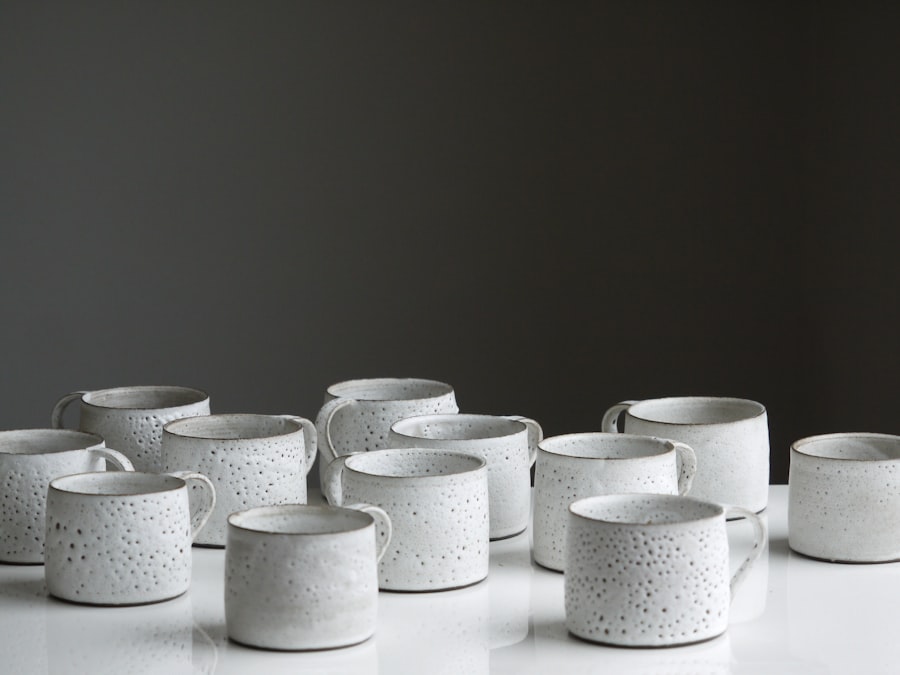Nerikomi, a traditional Japanese pottery technique, has its roots deeply embedded in the rich tapestry of Japanese ceramic history. This method, which translates to “mixed clay,” is characterised by its intricate layering and blending of different coloured clays to create striking patterns and designs. The origins of nerikomi can be traced back to the Edo period (1603-1868), a time when artisans began to experiment with various clay types and colours, seeking to elevate their craft beyond mere functionality.
The technique was particularly popular among potters in the Mino region, where the availability of diverse clay types allowed for innovative experimentation. The practice of nerikomi is not merely a technical endeavour; it is also a reflection of cultural aesthetics and philosophies. The Japanese have long held a deep appreciation for nature and its ephemeral beauty, which is often mirrored in their art forms.
Nerikomi embodies this ethos by allowing artists to capture the essence of natural elements through the interplay of colours and textures. As the technique evolved, it became a means for potters to express their individuality and creativity, leading to a rich variety of styles and interpretations that continue to inspire contemporary artists today.
Summary
- Nerikomi originated in Japan and is a traditional pottery technique that involves layering and manipulating different coloured clays to create intricate patterns.
- Materials and tools needed for Nerikomi include various coloured clays, a pottery wheel, cutting tools, and a kiln for firing the finished pieces.
- The process of creating Nerikomi art involves wedging and layering different coloured clays, then slicing and reassembling them to create unique patterns and designs.
- Colour is of utmost importance in Nerikomi, as the intricate patterns and designs are achieved through the use of different coloured clays and the careful manipulation of their placement and arrangement.
- Techniques for shaping and forming Nerikomi art include throwing on a pottery wheel, hand-building, and using molds to create different forms and shapes.
Materials and Tools Needed for Nerikomi
Selecting the Right Clay
The choice of clay is crucial, as it affects not only the final appearance of the piece but also its durability and functionality. Different clays can be mixed to achieve a range of colours and textures, allowing for endless creative possibilities.
The Importance of Colourants
In addition to clay, colourants play a significant role in nerikomi. Natural oxides such as iron oxide, cobalt oxide, and manganese oxide are commonly used to achieve vibrant hues. These colourants can be mixed into the clay body or applied as slips, providing artists with a versatile palette.
Essential Tools for the Creative Process
Tools such as rolling pins, knives, and various shaping implements are essential for manipulating the clay into desired forms. A slab roller can be particularly useful for creating uniform sheets of clay, while various moulds can help in shaping intricate designs. The right tools not only facilitate the creation process but also enhance the artist’s ability to express their vision.
The Process of Creating Nerikomi Art

Creating nerikomi art is a meticulous process that requires both skill and patience. The initial step involves preparing the coloured clays. Artists often begin by mixing different clays with colourants to achieve the desired shades.
Once the clays are prepared, they are rolled into thin sheets or coils, which will later be layered to form intricate patterns. This stage is crucial, as the way the colours are combined will ultimately dictate the final design of the piece. After preparing the coloured clays, the artist begins to layer them in a specific arrangement.
This layering can take various forms; some artists may choose to create geometric patterns, while others may opt for more organic designs inspired by nature. Once the layers are arranged, they are carefully compressed together to ensure they bond well. The next step involves cutting and shaping the layered clay into the desired form, whether it be a bowl, vase, or sculptural piece.
This shaping process requires a keen eye for detail and an understanding of how the colours will interact once fired. Each cut reveals new patterns and designs, making this stage both exciting and unpredictable.
The Importance of Colour in Nerikomi
Colour is perhaps one of the most defining aspects of nerikomi art. The interplay of different hues not only enhances the visual appeal of a piece but also conveys deeper meanings and emotions. In Japanese culture, colours often carry symbolic significance; for instance, red may represent good fortune, while blue can signify calmness and serenity.
By thoughtfully selecting and combining colours, artists can imbue their work with layers of meaning that resonate with viewers on multiple levels. Moreover, the way colours interact during the firing process adds another dimension to nerikomi art. As clay is subjected to high temperatures in the kiln, chemical reactions occur that can alter the appearance of colours.
Some hues may become more vibrant, while others may mellow or change entirely. This unpredictability is part of what makes nerikomi so captivating; each piece is unique, with its own story told through colour. Artists often embrace this element of surprise, using it as an opportunity to explore new creative avenues and push the boundaries of their craft.
Techniques for Shaping and Forming Nerikomi Art
Shaping and forming nerikomi art involves a variety of techniques that allow artists to manipulate clay into intricate designs. One common method is slab construction, where sheets of layered clay are cut into specific shapes and then assembled to create three-dimensional forms. This technique is particularly effective for creating flat surfaces that showcase the vibrant patterns inherent in nerikomi.
Another technique employed in nerikomi is coiling, where long ropes of clay are stacked upon one another to build up height and volume in a piece. This method allows for greater flexibility in design and can result in more organic shapes that mimic natural forms. Additionally, potters may use moulds to create consistent shapes or intricate details that would be challenging to achieve by hand alone.
Each technique offers unique advantages and challenges, allowing artists to choose methods that best suit their vision for each piece. Incorporating texture into nerikomi art is also essential for adding depth and interest. Artists may use tools such as stamps or carving implements to create surface patterns that complement the layered colours beneath.
This tactile quality invites viewers to engage with the piece on a sensory level, enhancing their overall experience of the artwork.
Firing and Finishing Nerikomi Pieces

The firing process is a critical stage in creating nerikomi art, as it transforms raw clay into durable ceramic pieces. Typically, nerikomi works are fired in a kiln at high temperatures ranging from 1,200°C to 1,300°C (2,192°F to 2,372°F). This high-temperature firing not only vitrifies the clay but also allows for chemical reactions between different colourants that can dramatically alter their appearance.
Artists must carefully consider their firing schedule and atmosphere—oxidation or reduction—since these factors can significantly influence the final outcome. After firing, pieces may undergo additional finishing processes such as glazing or polishing. Glazing can enhance colour vibrancy and add a glossy finish that accentuates the intricate patterns created during the nerikomi process.
Some artists opt for clear glazes that allow the underlying colours to shine through, while others may choose coloured glazes that interact with the layered clays in unexpected ways. Polishing techniques can also be employed to create a smooth surface that highlights the tactile qualities of the piece. The final touches on a nerikomi piece are often what elevate it from mere craftsmanship to true artistry.
Artists may choose to incorporate additional elements such as gold leaf or metallic accents that catch the light and draw attention to specific areas of their work. These finishing touches not only enhance visual appeal but also reflect the artist’s personal style and aesthetic sensibilities.
Contemporary Uses and Applications of Nerikomi
In recent years, nerikomi has experienced a resurgence in popularity among contemporary artists who seek to blend traditional techniques with modern sensibilities. Many potters are exploring new applications for nerikomi beyond functional ware; sculptural pieces that challenge conventional notions of pottery are becoming increasingly common. These works often incorporate abstract forms and experimental designs that push the boundaries of what nerikomi can achieve.
Moreover, contemporary artists are increasingly interested in sustainability and eco-friendly practices within their work. Many are turning to locally sourced clays and natural colourants derived from plants or minerals, aligning their artistic practices with broader environmental concerns. This shift not only reflects changing attitudes towards art-making but also fosters a deeper connection between artists and their materials.
Nerikomi is also finding its way into collaborative projects that bridge disciplines such as fashion and interior design. Designers are incorporating nerikomi techniques into textiles or ceramics used in home décor, creating unique pieces that celebrate craftsmanship while appealing to modern aesthetics. This cross-pollination between traditional pottery techniques and contemporary design illustrates how nerikomi continues to evolve while remaining rooted in its historical origins.
Tips and Tricks for Beginners in Nerikomi
For those new to nerikomi, embarking on this artistic journey can be both exciting and daunting. One essential tip for beginners is to start with small projects that allow for experimentation without overwhelming complexity. Simple shapes such as coasters or small bowls provide an excellent opportunity to practice layering colours and shaping techniques without committing to larger pieces.
Another important aspect is understanding clay behaviour during both preparation and firing stages. Beginners should take time to familiarise themselves with different types of clay and how they interact with colourants; this knowledge will prove invaluable when selecting materials for specific projects. Keeping detailed notes on colour combinations and firing results can help track successes and failures over time.
Patience is key when working with nerikomi; rushing through any stage can lead to unsatisfactory results or even ruin an entire piece. Taking time during each step—from preparing coloured clays to shaping and firing—ensures that artists can fully engage with their work and develop their skills gradually. Lastly, connecting with other artists through workshops or online communities can provide invaluable support and inspiration for beginners in nerikomi.
Sharing experiences, techniques, and challenges fosters a sense of camaraderie among practitioners while encouraging growth within this beautiful art form.
If you’re intrigued by the Nerikomi technique and its meticulous approach to art, you might also appreciate exploring the innovative styles of other renowned artists. For instance, Pablo Picasso, a master of modern art, continuously experimented with form and colour, much like the layered intricacies found in Nerikomi. To delve deeper into Picasso’s revolutionary contributions to art, consider reading An Introduction to the Artist Pablo Picasso, which offers a comprehensive look at his life, influences, and enduring legacy. This article could provide further insights into how artists like Picasso have shaped contemporary artistic techniques and perspectives.




